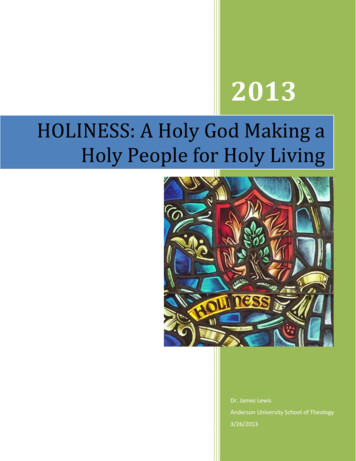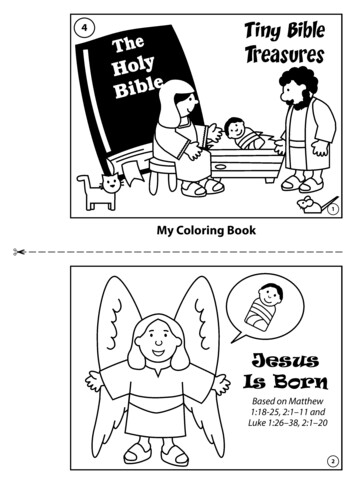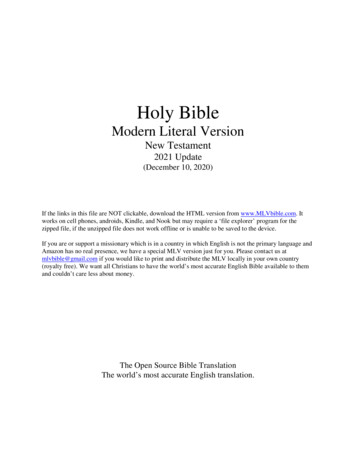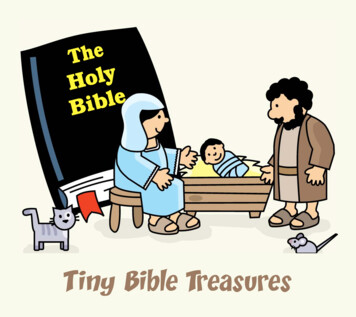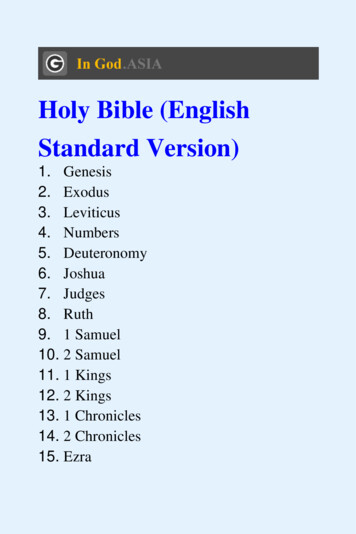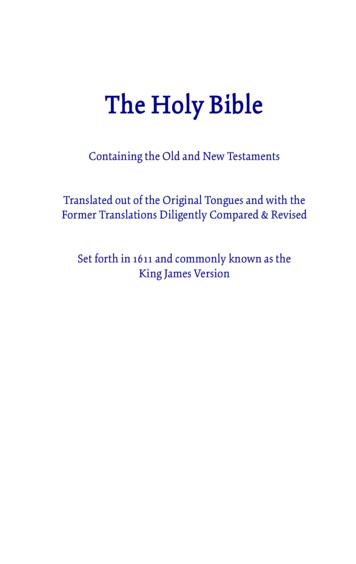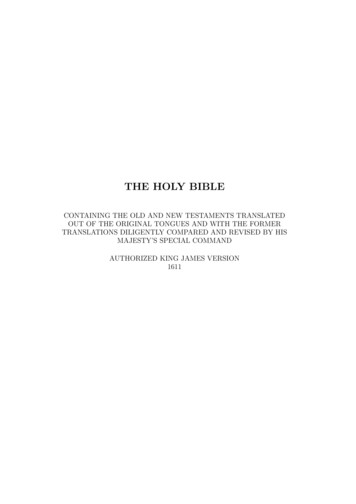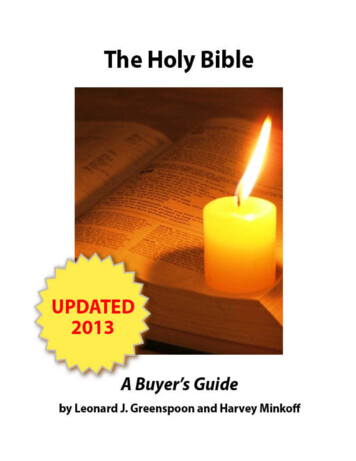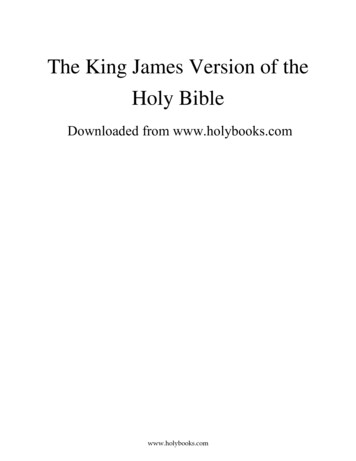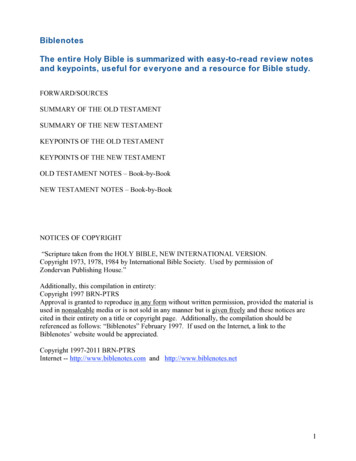
Transcription
BiblenotesThe entire Holy Bible is summarized with easy-to-read review notesand keypoints, useful for everyone and a resource for Bible study.FORWARD/SOURCESSUMMARY OF THE OLD TESTAMENTSUMMARY OF THE NEW TESTAMENTKEYPOINTS OF THE OLD TESTAMENTKEYPOINTS OF THE NEW TESTAMENTOLD TESTAMENT NOTES – Book-by-BookNEW TESTAMENT NOTES – Book-by-BookNOTICES OF COPYRIGHT“Scripture taken from the HOLY BIBLE, NEW INTERNATIONAL VERSION.Copyright 1973, 1978, 1984 by International Bible Society. Used by permission ofZondervan Publishing House.”Additionally, this compilation in entirety:Copyright 1997 BRN-PTRSApproval is granted to reproduce in any form without written permission, provided the material isused in nonsaleable media or is not sold in any manner but is given freely and these notices arecited in their entirety on a title or copyright page. Additionally, the compilation should bereferenced as follows: “Biblenotes” February 1997. If used on the Internet, a link to theBiblenotes’ website would be appreciated.Copyright 1997-2011 BRN-PTRSInternet -- http://www.biblenotes.com and http://www.biblenotes.net1
Forward:The Important Points of the Bible are in this Review.Everyone should learn something about the Bible, regardless of his religious preferences. TheBible presents a historical religion and is very difficult to read and understand. For these reasons,these Bible Review Notes were written as a compilation of important points from the viewpoint ofa scientist/engineer/researcher. There has been no attempt to discuss or debate these points, merelyto present them in summarized fashion.Biblenotes was published on the web March 12, 1997. The summaries took one year to complete.Over one million readers have used this site for information, education and review.Biblenotes has been awarded a Five Star Rating in 2000 by Schoolzone's panel of over 400 expertteachers.The Hot Site for the day was awarded to Biblenotes on June 16, 1999 by USA Today.2
Sources:The Holy Bible, New International Version (International Bible Society; The ZondervanCorporation, Grand Rapids, Michigan; 1991) was used for quoted verses for the great majority ofthis work: See Notice of Copyright. Also The Holy Bible, King James Version (American BibleSociety, New York; 1992) was used for some references that are better known in the wording ofthe King James Version. When not stated, the verses are from The Holy Bible, New InternationalVersion (NIV ). All verses and references are given in standard form of Book, Chapter: Verse -- asin this example:1 Kings 11:5-7where 1 Kings Book11 Chapter5-7 Verses 5 through 7The Living Bible (Tyndale House Publishers, Wheaton, Illinois; 1972) was also used for reading asan aid in this work, because of its simplicity in wording/paraphrases.The 39 books of the Old Testament are reviewed in order of presentation in the NIV in OLDTESTAMENT NOTES -- Book-by-Book. The 27 books of the New Testament are reviewed inorder of presentation in the NIV in NEW TESTAMENT NOTES -- Book-by-Book. Additionallyboth the Old and New Testaments are reviewed in an overall short summary.3
Summary of the Old Testament:After Adam and Eve, the Hebrew lineage truly began with Abraham (about 1900 B.C.).Abraham's Personal Covenant (contract) with God (Genesis 12, 15, 17)God said that Abraham would be the father of "many nations" and that Abraham and hisdescendants should circumcise the male babies on the eighth day after birth to seal the contract.From Abraham came Isaac, then Jacob (whose name was changed to Israel), who had twelvesons, giving rise to the twelve "tribes" of Israel. One of Jacob's sons, Joseph, was sold into slaveryin Egypt, leading to Jacob and his family coming to Egypt and later their descendents becomingslaves in Egypt. Moses (about 1250 B.C.) led the Exodus (freeing of Israelites from bondage)from Egypt and the Covenant of God with the Hebrew nation was made:Hebrew People's Covenant (Old Covenant) with God (Exodus 34:27-28)God gave the people the Ten Commandments for the people of Israel to obeyin order that He be their God.There were constant problems with the Jewish people believing in idols and other "gods." Finallythe people reached the Promised Land and settled there after Moses' death. "Judges" led the peopleuntil about 1000 B.C. when Kings were installed, yet these were still thought of as people doingGod's bidding (not as other nations' kings which had all power being theirs alone). King David andKing Solomon led a united, strong country -- which became divided after Solomon's death:Southern Kingdom -- called Judah, though consisting of both the "tribes"of Judah and Benjamin; this group included the city of Jerusalem.The Southern Kingdom fell to the Babylonians in 586 B.C.Northern Kingdom-- called Israel, consisting of the other 10 "tribes"; this group includedSamaria. The Northern Kingdom fell to the Assyrians around 722 B.C.Although the Hebrews rebuilt the Temple in Jerusalem in 520 B.C., they never regained strengthand were eventually conquered by Rome.The struggles of the Hebrew people and their dispersion from their country were thought to befrom their belief in idols and heathen "gods" (mostly resulting from their marrying non-Jews whobrought in outside religions). The prophets (including Elijah, Elisha, Isaiah, Jeremiah, Ezekiel)were spokesmen for God to the people and to their leaders: they often disagreed with the men inpower and had no fear of expressing their messages from God -- generally directing against theidolatry and "false gods."There are many points of wisdom (Books of Proverbs, Ecclesiastes, Job). Poems and hymns of theHebrew people are expressed in Psalms. In the latter writings, there was a general belief in the4
"last days" (of the future around their time or at a time to come) and of the Messiah who wouldlead them with great power.Summary of the New Testament:Jesus Christ's life (from the virgin birth to His ministry, crucifixion, and resurrection) is the basisfor the four Gospels -- the books of Matthew, Mark, Luke, and John. Jesus taught to love others asmuch as yourself and to love God as the one and only God. Jesus performed many miracles andhealings, described the Kingdom of Heaven, and told people how to live as God wished them tolive. Jesus' many story-illustrations were used to direct the people with things familiar to them.Jesus selected twelve disciples (since there were 12 "tribes" of Israel) to help Him and to spreadthe Word of God. Conflict with religious leaders (Pharisees and Sadducees) led to His crucifixion(death on the cross) after it was approved by Roman leaders (At the time of Jesus, Rome ruled theJewish people, who longed for freedom.). Jesus Christ's death/sacrifice led to the:New Covenant (contract) of God with all people (Jews and Gentiles [non-Jews])(1) Written in their minds and hearts(2) All who believe on Him are forgiven by Jesus Christ's sacrifice (by His blood)to take away their sins.Refer to: Jeremiah 31:33 (Old Testament reference)Matthew 26:28Mark 14:24Luke 22:20Romans 8:3Philippians 3:9Hebrews 8:10Hebrews 9:15Hebrews 10:9-10which is further described byJohn 3:16-- (from King James' Version)"For God so loved the world, that He gave His only begotten Son, that whosoever believeth inHim should not perish, but have everlasting life."The requirements for Christians: are given in 1 John 3:23"And this is His command: to believe in the name of His Son Jesus Christ, and to love oneanother."After Christ's death and resurrection, Paul became converted to Christianity and extended theteachings to the Gentiles (Greeks, Romans, and other non-Jews), accounting for the early, rapidgrowth of Christianity in spite of great persecution of the believers. Jesus' death and resurrectionand His expected return at the "last days" were told by Paul. Life after death was described byPaul (1 Corinthians 15:35-58), with a new, non-earthly body. The Revelation and other writingsaddress the "last days" with Christians given life in heaven and others given to "the Lake of Fire"(hell).5
Key Points of the Old Testament:The key points listed below list the chapters to read in the Bible for each point.The links go back to the summary pages. First Sin Story (Adam and Eve) Noah and his Ark Tower of Babel (causing differing languages) Abraham's Personal Covenant with God Test of Abraham (to sacrifice Isaac) Isaac's Blessing (given to Jacob, not Esau, by trickery) Joseph's Coat (and his being sold to slavery in Egypt) Burning Bush (God appoints Moses to lead Israel) Passover (Israel's first born children were saved) TEN COMMANDMENTS (Old Covenant) Jericho (walls crumble to allow Hebrew battle victory) Samson and Delilah David and Golaith David and Bathsheba King Solomon's Baby Decision Elijah (and his showdown with prophets of Baal) Elisha (and his miracles) Esther (saving the Jews from destruction) Job (his suffering, although a good person)Genesis 2, 3Genesis 6-8Genesis 11Genesis 12,15 & 17Genesis 22Genesis 27Genesis 37Exodus 3:2-4:17Exodus 12:21-27Exodus 20-3-17;Joshua 6Judges 13-161 Samuel 16,172 Samuel 111 Kings 3:16-271 Kings 17-192 Kings 2-7EstherJob6
Very Famous Psalms (poems, hymns, prayers) Psalms 118:24Psalms 23 (most remembered) Wisdom notes/ethics Ecclesiastes Very Famous Section Isaiah's Very Famous Statement Jeremiah's Famous Point Valley of the Dry Bones Ezekiel's Famous Point The Fiery Furnace (Shadrach, Meshach, Abednego) The Lion's Den (Daniel saved from lions) Jonah and the WhaleProverbsEcclesiastes 3:1-8Isaiah 2:4Jeremiah 32:19Ezekiel 37Ezekiel 18:2Daniel 3Daniel 6Jonah 1,2Points on the "last days"------------- Isaiah 2,9,13,24,25,29,30,34,35,40,60,65,66Jeremiah 25,30,31 (the "New Covenant")Ezekiel 20,30,38Daniel 8,10,12Micah 4Zephaniah 1,2,3Zechariah 2,12,14Malachi 3,4Points on "the Messiah"------------ Isaiah 7,9,11,42,52,53Jeremiah 23,33Ezekiel 34Daniel 7,9Micah 5Zechariah 3,6,9,10Malachi 47
Key Points of the New Testament:The key points listed below list the chapters to read in the Bible for each point.The links go back to the summary pages.Jesus Life Story--------------------------------Matthew, Mark, Luke, John Jesus' Birtho Matthew 2o Luke 2Jesus at Twelve Years Oldo Luke 2Jesus' Baptismo Matthew 3o Mark 1o Luke 3Jesus' Transfigurationo Matthew 17o Mark 9o Luke 9Jesus in Jerusalemo Matthew 21o Mark 11o Luke 19Jesus' Last Suppero Matthew 26o Mark 14o Luke 22o John 13Jesus' Trialo Matthew 26,27o Mark 14,15o Luke 22,23o John 18,19Jesus' Crucifixiono Matthew 27o Mark 15o Luke 23o John 19Jesus' Resurrectiono Matthew 28o Mark 16o Luke 24o John 20Jesus' Kingdom of Heaveno Matthew 5,8,10,12,13,18,198
Mark 4Luke 6,12,13,17Jesus' Statements on How to Liveo Matthew 5,6,7,18,23o Mark 12Jesus' Story-Illustrationso Matthew 7,13,18,20,22,23,25o Mark 12o Luke 8,11,12,14,15,16,18,19,20o John 10Stories About Jesuso Mark 2o Luke 5,7,10,17,18,19o John 2,3,4,6,9Lazarus Raised from the Deado John 11Jesus' Healings/Miracleso Matthew 8,9,14,15,20o Mark 4,5,6,7,8,10o Luke 5,6,7,8,9,13,18o John 4,5,6Jesus' Other Main Pointso Matthew 11,12,16,17,20,25,26o Mark 3,6,10,12o Luke 12,13,14,16,17,20o John 5,8,10,12Jesus' Pharisees/Sadducees Disagreementso Matthew 12,15,22o Mark 7,10o Luke 5,6,11,20o John 8Jesus/Disciples Interactionso Matthew 5,6,7o Mark 8,9,10,12,13o Luke 6,9,10,18o John 14,15,16,17Jesus' Points on the "last days"o Matthew 24o Mark 13o Luke 17,21o John 5,12oo 12 Disciples/Apostles: Matthew 10:2-4Luke 6:13-169
New Covenant of God with the People: Matthew 26:28Mark 14:24Luke 22:20Romans 8:3Philippians 3:9Hebrews 8:10Hebrews 9:15Hebrews 10:9-10Sermon on the Mount------------------------------------- Matthew 5,6,7The -------Matthew 5:3-12The Lord's Prayer -----------------------------------------Matthew 6:9-13Very Often-Quoted Verse---------------------------------John 3:16"In Remembrance" of Jesus (Communion/Eucharist): Matthew 26:26-29Mark 14:22-24Luke 22:19-20First Corinthians 10:16-17; 11:23-26The Great Gift: Matthew 26:6-13Mark 14:1-9John 12:1-8"Doubting -----John 20:25-29Jesus after CrucifixionActs 1Disciples/Apostles Miracles:Acts 9,16,20Stephen --------Acts 7Paul's Way to -Ephesians 5:20Paul's Dead-to-Life Questions (Seed Yields Plant):1 Corinthians 15:35-58Paul's Christian Soldiers Ephesians 6:10-17First Thessalonians 5:8Famous Statements from Paul10
Romans 8:31First Corinthians 10:31First Corinthians 13:13Galatians 6:7First Thessalonians 5:1-2Second Timothy 4:7Conversion of Saul (renamed Paul) to Christianity Acts 9,22Paul's Ministry and Growth of Christianity Main Pointso Romans (main Christian thoughts) 5,6,8,11,12,13,14,15o First Corinthians 7,8,10,11,14,15o Second Corinthians 3,5o Galatians 2,5,6o Ephesians 5,6o First Timothy 2Paul's Points on the "last days"o Romans 11o First Corinthians 1,7,10,15o Ephesians 1o First Thessalonians 4,5o Second Thessalonians 1,2Paul's Other Pointso First Corinthians 6,10,11,12,13,16o Second Corinthians 5,7o Ephesians 4o Philippians 3,4o Colossians 1,2,3o First Thessalonians 4,5o First Timothy 6Paul's Predestination Beliefso Romans 8,9o First Corinthians 1,2o Ephesians 1Jesus Likened to Melchizedek------------------------------ Hebrews 7:24-25Command for Christians---------------------------------- 1 John 3:23God is ----- 1 John 4:8,9Description of John's Vision of the "last days"----------- RevelationooJudgment: Revelation 20:11-15New Jerusalem (i.e., Heaven): Revelation 21,2211
Further Points on the "last days"Second Peter 3Old Testament Notes – Book-by-Book:The Old Testament of the Bible covers mostly the time from around 1500 B.C. to 100 A.D. Thefirst five books are the Pentateuch (or the Books of Mo
Also The Holy Bible, King James Version (American Bible Society, New York; 1992) was used for some references that are better known in the wording of the King James Version. When not stated, the verses are from The Holy Bible, New International Version (NIV). All verses and references are given in standard form of Book, Chapter: Verse -- as
